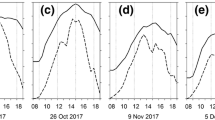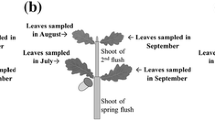Abstract
Effects of nitrogen (Ν) and water supply on grapevine leaf transmittance and canopy reflectance were studied over 2 years (2009–2010) in two vineyards planted with cvs. Cabernet Sauvignon and Xinomavro (Vitis vinifera L.) located in northern Greece. Three N (0, 60 and 120 kg ha−1) and two irrigation (irrigated at 70 % of crop evapotranspiration and non-irrigated) treatments were managed in triplicate in randomized blocks. Measurements with two transmittance-based chlorophyll meters (CM: SPAD-502 and CCM-200) and two active canopy sensors (Crop Circle ACS-210; amber band and Crop Circle ACS-430; red and red edge bands) were conducted on four and two growth stages, respectively. Fertilization increased leaf N and chlorophyll concentrations, as well as CM readings and vegetation indices. The CCM and SPAD values did not vary across growth stages and better estimated leaf N and chlorophyll concentrations in Cabernet Sauvignon than in Xinomavro. The SPAD readings provided better predictions of leaf N concentration. The vegetation indices of the ACS-430 sensor correlated with leaf N and chlorophyll concentrations and dormant wood in Cabernet Sauvignon; the red edge-based indices were generally more efficient than the red-based indices. Consistent relationships were observed for all ACS-430 indices with yield and for red edge-based indices with total phenols early in the season for both vineyards. The correlation between ACS-210 sensor indices and vine properties was low. These results showed that the two technologies examined could provide information on grapevine performance early in the season but have limitations that may restrict their use in vineyards because the acquired relationships were not consistent across vineyards and instruments.






Similar content being viewed by others
References
Arnon, D. I. (1949). Copper enzymes in isolated chloroplasts—Polyphenoloxidase in Beta vulgaris. Plant Physiology, 24, 1–15.
Baluja, J., Diago, M. P., Goovaerts, P., & Tardaguila, J. (2012). Assessment of the spatial variability of anthocyanins in grapes using a fluorescence sensor: Relationships with vine vigour and yield. Precision Agriculture, 13, 457–472.
Barker, D., & Sawyer, J. (2010). Using active canopy sensors to quantify corn nitrogen stress and nitrogen application rate. Agronomy Journal, 102, 964–971.
Bell, S. J., & Robson, A. (1999). Effect of nitrogen fertilization on growth, canopy density, and yield of Vitis vinifera L. cv. Cabernet Sauvignon. American Journal of Enology and Viticulture, 50, 351–358.
Bergqvist, J., Dokoozlian, N., & Ebisuda, N. (2001). Sunlight exposure and temperature effects on berry growth and composition of Cabernet Sauvignon and Grenache in the Central San Joaquin Valley of California. American Journal of Enology and Viticulture, 52, 1–7.
Bramley, R. G. V. (2010). Precision viticulture: Managing vineyard variability for improved quality outcomes. Managing wine quality: Viticulture & wine quality, 1, 445–480.
Bramley, R. G. V., Le Moigne, M., Evain, S., Ouzman, J., Florin, L., Fadaili, E. M., et al. (2011). On-the-go sensing of grape berry anthocyanins during commercial harvest: Development and prospects. Australian Journal of Grape and Wine Research, 17, 316–326.
Chaves, M. M., Zarrouk, O., Francisco, R., Costa, J. M., Santos, T., Regalado, A. P., et al. (2010). Grapevine under deficit irrigation: Hints from physiological and molecular data. Annals of Botany, 105, 661–676.
Choné, X., Van Leeuwen, C., Dubourdieu, D., & Gaudillère, J. P. (2001). Stem water potential is a sensitive indicator of grapevine water status. Annals of Botany, 87, 477–483.
Coombe, B. G. (1995). Growth stages of the grapevine: Adoption of a system for identifying grapevine growth stages. Australian Journal of Grape and Wine Research, 1, 104–110.
Dai, Z. W., Ollat, N., Gomes, E., Decroocq, S., Tandonnet, J.-P., Bordenave, L., et al. (2011). Ecophysiological, genetic, and molecular causes of variation in grape berry weight and composition: A review. American Journal of Enology and Viticulture, 62, 413–425.
Drissi, R., Goutouly, J. P., Forget, D., & Gaudillere, J. P. (2008). Nondestructive measurement of grapevine leaf area by ground normalized difference vegetation index. Agronomy Journal, 101, 226–231.
Evans, J. R. (1989). Photosynthesis and nitrogen relationships in leaves of C3 plants. Oecologia, 78, 9–19.
Gitelson, A. A., Gritz, Y., & Merzlyak, M. N. (2003). Relationships between leaf chlorophyll content and spectral reflectance and algorithms for non-destructive chlorophyll assessment in higher plant leaves. Journal of Plant Physiology, 160, 271–282.
Hall, A., Lamb, D., Holzapfel, B., & Louis, J. (2002). Optical remote sensing applications in viticulture—A review. Australian Journal of Grape and Wine Research, 8, 36–47.
Hall, A., Lamb, D. W., Holzapfel, B. P., & Louis, J. P. (2011). Within-season temporal variation in correlations between vineyard canopy and winegrape composition and yield. Precision Agriculture, 12, 103–117.
Hatfield, J., Gitelson, A., Schepers, J., & Walthall, C. L. (2008). Application of spectral remote sensing for agronomic decisions. Agronomy Journal, 100, S117–S131.
Howell, G. S. (2001). Sustainable grape productivity and the growth-yield relationship: A review. American Journal of Enology and Viticulture, 52, 165–174.
Jifon, J. L., Syvertsen, J. P., & Whaley, E. (2005). Growth environment and leaf anatomy affect nondestructive estimates of chlorophyll and nitrogen in Citrus sp leaves. Journal of the American Society for Horticultural Science, 130, 152–158.
Johnson, L. F. (2003). Temporal stability of an NDVI-LAI relationship in a Napa Valley vineyard. Australian Journal of Grape and Wine Research, 9, 96–101.
Johnson, L. F., Roczen, D. E., Youkhana, S. K., Nemani, R. R., & Bosch, D. F. (2003). Mapping vineyard leaf area with multispectral satellite imagery. Computers and Electronics in Agriculture, 38, 33–44.
Keller, M. (2005). Deficit irrigation and vine mineral nutrition. American Journal of Enology and Viticulture, 56, 267–283.
Keller, M., Kummer, M., & Vasconcelos, M. C. (2001). Soil nitrogen utilisation for growth and gas exchange by grapevines in response to nitrogen supply and rootstock. Australian Journal of Grape and Wine Research, 7, 2–11.
Koundouras, S., Hatzidimitriou, E., Karamolegkou, M., Dimopoulou, E., Kallithraka, S., Tsialtas, J. T., et al. (2009). Irrigation and rootstock effects on the phenolic concentration and aroma potential of Vitis vinifera L. cv. Cabernet Sauvignon grapes. Journal of Agricultural and Food Chemistry, 57, 7805–7813.
Koundouras, S., Tsialtas, I. T., Zioziou, E., & Nikolaou, N. (2008). Rootstock effects on the adaptive strategies of grapevine (Vitis vinifera L. cv. Cabernet-Sauvignon) under contrasting water status: Leaf physiological and structural responses. Agriculture, Ecosystems & Environment, 128, 86–96.
Lamb, D. W., Weedon, M. M., & Bramley, R. G. (2004). Using remote sensing to predict grape phenolics and colour at harvest in a Cabernet Sauvignon vineyard: Timing observations against vine phenology and optimising image resolution. Australian Journal of Grape and Wine Research, 10, 46–54.
Linsenmeier, A. W., Loos, U., & Lohnertz, O. (2008). Must composition and nitrogen uptake in a long-term trial as affected by timing of nitrogen fertilization in a cool-climate riesling vineyard. American Journal of Enology and Viticulture, 59, 255–264.
Markwell, J., Osterman, J. C., & Mitchell, J. L. (1995). Calibration of the Minolta SPAD-502 leaf chlorophyll meter. Photosynthesis Research, 46, 467–472.
Meggio, F., Zarco-Tejada, P. J., Nunez, L. C., Sepulcre-Canto, G., Gonzalez, M. R., & Martin, P. (2010). Grape quality assessment in vineyards affected by iron deficiency chlorosis using narrow-band physiological remote sensing indices. Remote Sensing of Environment, 114, 1968–1986.
Neilsen, G. H., Neilsen, D., Bowen, P., Bogdanoff, C., & Usher, K. (2010). Effect of timing, rate, and form of N fertilization on nutrition, vigor, yield, and berry yeast-assimilable N of grape. American Journal of Enology and Viticulture, 61, 327–336.
Netto, A. T., Campostrini, E., de Oliveira, J. G., & Bressan-Smith, R. E. (2005). Photosynthetic pigments, nitrogen, chlorophyll a fluorescence and SPAD-502 readings in coffee leaves. Scientia Horticulturae, 104, 199–209.
Pinter, P. J, Jr, Hatfield, J. L., Schepers, J. S., Barnes, E. M., Moran, M. S., Daughtry, C. S., et al. (2003). Remote sensing for crop management. Photogrammetric Engineering and Remote Sensing, 69, 647–664.
Poni, S., Intrieri, C., & Silvestroni, O. (1994). Interactions of leaf age, fruiting, and exogenous cytokinins in Sangiovese grapevines under non-irrigated conditions. II. Chlorophyll and nitrogen content. American Journal of Enology and Viticulture, 45, 278–284.
Ribéreau-Gayon, P., & Stonestreet, E. (1965). Le dosage des anthocyanes dans les vins rouges. Bulletin de la Societé Chimique de France, 9, 2649–2652.
Ribéreau-Gayon, P., & Stonestreet, E. (1966). Dosage des tanins du vin rouge et détermination de leur structure. Chimie Analytique, 48, 188–196.
Robinson, J. B. (2005). Critical plant tissue values and application of nutritional standards for practical use in vineyards. In Soil environment and vine mineral nutrition symposium (pp. 61–68). San Diego, California, USA. American Society forEnology and Viticulture.
Romero, P., Fernández-Fernández, J., & Martinez-Cutillas, A. (2010). Physiological thresholds for efficient regulated deficit-irrigation management in winegrapes grown under semiarid conditions. American Journal of Enology and Viticulture, 61, 300–312.
Rouse, J.W. Jr., Haas, R.H., Schell, J.A., & Deering, D.W. (1973). Monitoring vegetation systems in the great plains with ERTS. Proceedings of the 3rd ERTS Symposium, NASA SP-351 (U.S. Government Printing Office: Washington DC.), 1, 309–317.
Saint-Criq, N., Vivas, N., & Glories, Y. (1998). Maturité phénolique: définition et contrôle. Revue Française d’Oenologie, 173, 22–25.
Schepers, J. S., Francis, D. D., & Thompson, M. T. (1989). Simultaneous determination of total C, total N, and 15 N on soil and plant material 1. Communications in Soil Science and Plant Analysis, 20, 949–959.
Schepers, J. S., Francis, D. D., Vigil, M., & Below, F. E. (1992). Comparison of corn leaf nitrogen concentration and chlorophyll meter readings. Communications in Soil Science and Plant Analysis, 23, 2173–2187.
Smart, R. (1991). Canopy microclimate implications for nitrogen effects on yield and quality. In M. J. Rantz (Ed.), Proceedings of the International Symposium on nitrogen in grapes and wine (pp. 90–101). Seattle, Washington: American Society for Enology and Viticulture, ASEV.
Stamatiadis, S., Taskos, D., Tsadila, E., Christofides, C., Tsadilas, C., & Schepers, J. S. (2010). Comparison of passive and active canopy sensors for the estimation of vine biomass production. Precision Agriculture, 11, 306–315.
Stamatiadis, S., Taskos, D., Tsadilas, C., Christofides, C., Tsadila, E., & Schepers, J. S. (2006). Relation of ground-sensor canopy reflectance to biomass production and grape color in two merlot vineyards. American Journal of Enology and Viticulture, 57, 415–422.
Steele, M., Gitelson, A. A., & Rundquist, D. (2008). Nondestructive estimation of leaf chlorophyll content in grapes. American Journal of Enology and Viticulture, 59, 299–305.
Tagarakis, A., Liakos, V., Fountas, S., Koundouras, S., & Gemtos, T. A. (2012). Management zones delineation using fuzzy clustering techniques in grapevines. Precision Agriculture, 14, 18–39.
Van Leeuwen, C., Trégoat, O., Choné, X., Gaudillère, J. P., & Pernet, D. (2008). Different environmental conditions, different results: The role of controlled environmental stress on grape quality potential and the way to monitor it. In R. Blair (Ed.), Proceedings of the Thirteenth Australian wine industry technical conference (pp. 39–46). Adelaide, South Australia, 28 July to 2 August 2007. Winetitles.
Williams, L. E., Phene, C. J., Grimes, D. W., & Trout, T. J. (2003). Water use of mature Thompson Seedless grapevines in California. Irrigation Science, 22, 11–18.
Yang, C., & Everitt, J. H. (2000). Relationships between yield monitor data and airborne multispectral digital imagery. In Proceedings of the 5th International Conference on Precision Agriculture (pp. 1–14). Bloomington, Minnesota, USA.
Author information
Authors and Affiliations
Corresponding author
Rights and permissions
About this article
Cite this article
Taskos, D.G., Koundouras, S., Stamatiadis, S. et al. Using active canopy sensors and chlorophyll meters to estimate grapevine nitrogen status and productivity. Precision Agric 16, 77–98 (2015). https://doi.org/10.1007/s11119-014-9363-8
Published:
Issue Date:
DOI: https://doi.org/10.1007/s11119-014-9363-8




